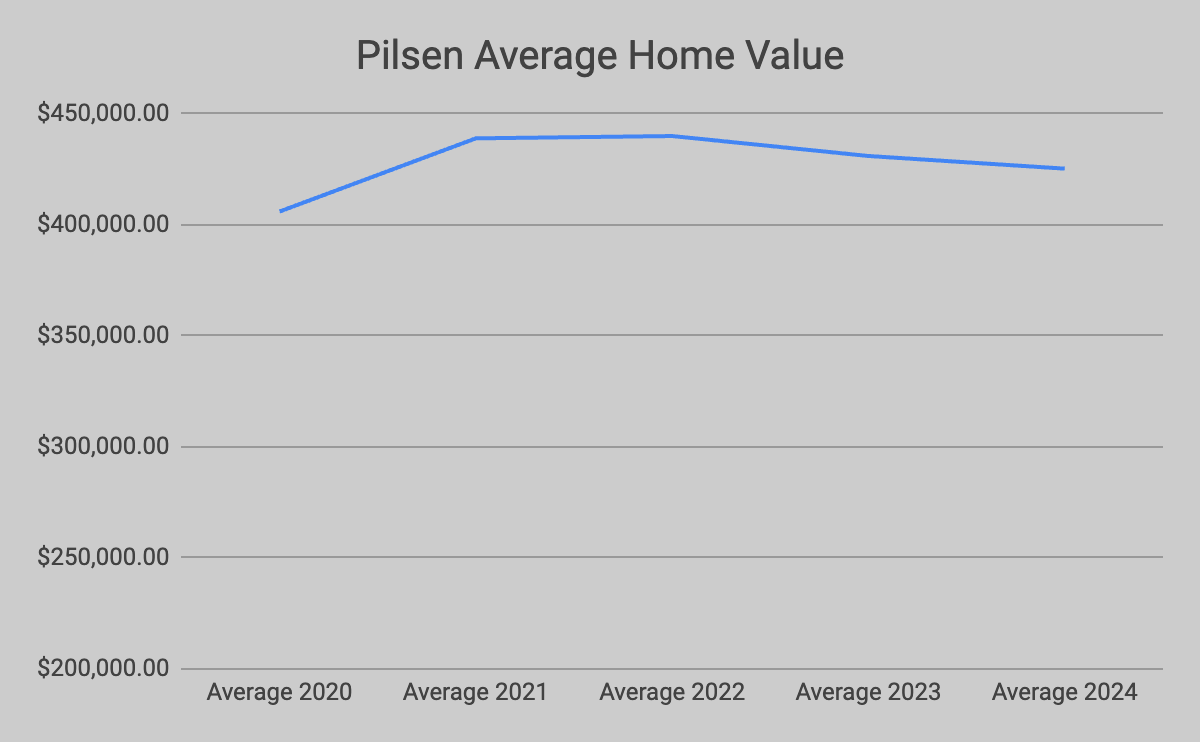Pilsen: The Heart of Chicago’s Lower West Side
Mar 13, 2025
Pilsen, a vibrant and culturally rich neighborhood on Chicago’s Lower West Side, is known for its deep-rooted immigrant history, stunning murals, and thriving arts scene. Bounded by the Chicago River to the east, Western Avenue to the west, 16th Street to the north, and the South Branch of the Chicago River to the south, Pilsen has long been a home to working-class communities that have shaped its identity. Over the decades, it has transformed into a cultural hotspot, blending tradition with modern innovation.
Pilsen by the Numbers



Origins and Early History
Pilsen’s origins date back to the mid-19th century when waves of European immigrants, primarily from Bohemia (modern-day Czech Republic), settled in the area. The neighborhood was named after Plzeň, a city in the Czech Republic known for its beer. These early residents built churches, schools, and businesses, establishing Pilsen as a working-class enclave.
By the late 19th and early 20th centuries, Pilsen saw an influx of German, Polish, and Lithuanian immigrants, further diversifying the community. As Chicago industrialized, the neighborhood became a hub for factory workers, with many residents employed in manufacturing and railroad industries. The construction of large, ornate buildings and social halls reflected the communal spirit of these early settlers.
Transformation and Evolution
Midway through the 20th century, demographic shifts began reshaping Pilsen. Mexican immigrants arrived in large numbers, particularly after World War II, as urban renewal and expressway construction displaced Latino communities from other parts of the city. By the 1960s, Pilsen had become one of Chicago’s most significant Mexican-American neighborhoods, a distinction it holds to this day.
This transformation brought new cultural influences, including vibrant street murals inspired by the Chicano movement, the establishment of taquerias and bakeries, and the preservation of public spaces for community gatherings. The neighborhood’s Mexican identity remains deeply woven into its fabric, even as recent gentrification has introduced new businesses and residents.
Historical Landmarks and Structures
Pilsen boasts a wealth of historic and artistic landmarks that highlight its rich heritage:
- National Museum of Mexican Art – One of the largest collections of Mexican art in the U.S., showcasing traditional and contemporary works.
- Thalia Hall – A historic concert venue and cultural hub, originally built in 1892 as a gathering space for the Czech community.
- Pilsen Murals – Located throughout the neighborhood, these murals depict themes of social justice, immigration, and Mexican heritage.
- St. Adalbert Church – A stunning Catholic church built in the early 20th century, representing the Polish and later Mexican influence in Pilsen.
- Harrison Park – A central community space that hosts festivals, sporting events, and neighborhood gatherings.
Historical Figures
Pilsen has been home to influential figures who have shaped its cultural and social landscape:
- Rudy Lozano – A labor and community activist who fought for immigrant rights and political representation.
- Mario Castillo – One of the first muralists to bring large-scale public art to Pilsen, inspiring future generations.
- Carlos Tortolero – Founder of the National Museum of Mexican Art, dedicated to preserving and promoting Mexican culture in Chicago.
Historical Events
Several significant events have defined Pilsen’s history:
- 1960s Chicano Movement – Local activists fought for civil rights, labor rights, and improved living conditions for Mexican-Americans.
- Protests Against Gentrification (2000s-Present) – As rising property values displaced long-time residents, community groups have organized efforts to preserve the neighborhood’s affordability and culture.
- Day of the Dead Celebrations – Annual events celebrating Mexican heritage, featuring altars, parades, and traditional music.
Current Trends and Redevelopment
Pilsen remains a neighborhood in transition, balancing its cultural heritage with new developments:
- Arts and Culture Boom – Galleries, street art, and music venues continue to attract artists and visitors from across the city.
- Gentrification and Rising Housing Costs – New luxury apartments and businesses have changed the neighborhood’s economic landscape, sparking ongoing debates about affordability and displacement.
- Community Advocacy – Grassroots organizations work to maintain affordable housing and cultural preservation, ensuring long-time residents can remain in Pilsen.
- Food Scene Expansion – While traditional Mexican eateries remain a staple, new restaurants blending global cuisines have emerged, adding to Pilsen’s reputation as a culinary destination.
Conclusion
Pilsen stands as one of Chicago’s most dynamic and culturally significant neighborhoods. From its European immigrant roots to its transformation into a Mexican-American stronghold, the neighborhood embodies resilience, creativity, and community pride. Whether exploring its vibrant murals, attending a festival, or dining in a local taqueria, Pilsen offers a rich and immersive experience that reflects the spirit of Chicago’s Lower West Side.
Stay connected with news and updates!
Join our mailing list to receive the latest news and updates from our team.
Don't worry, your information will not be shared.
We hate SPAM. We will never sell your information, for any reason.

